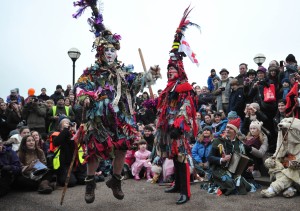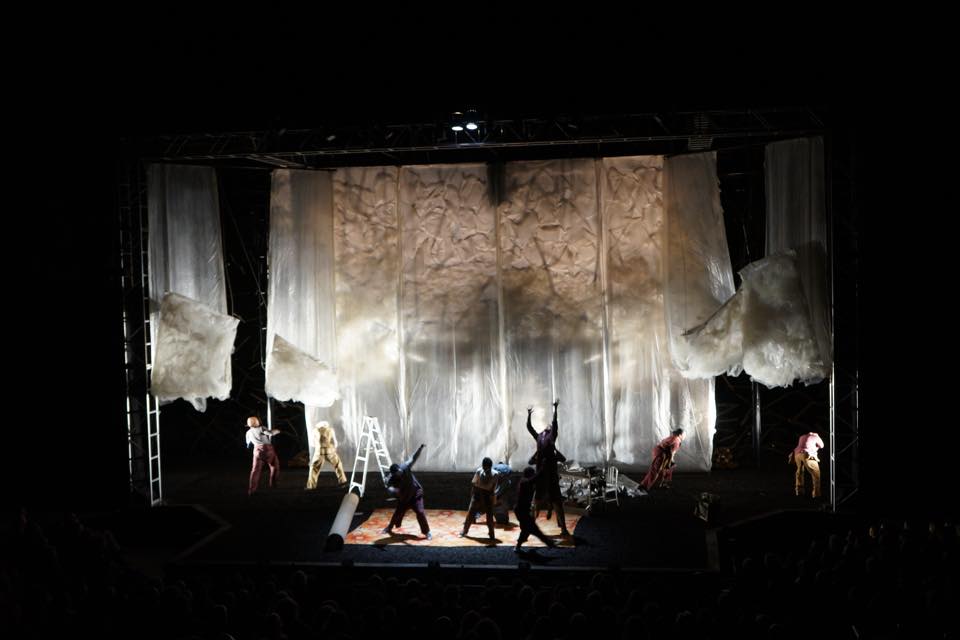Over-incarceration. Measure for Measure at Marin Shakes
July 7, 2019 § Leave a Comment
Our traumatized times speak eloquently to and through Robert Currier’s production of Measure for Measure for the Marin Shakespeare Company, which opened their thirtieth season on Saturday, June 28.
Until recently, MM was relatively rarely performed. In our #MeToo moment, however, its two abused and disbelieved heroines suddenly look a great deal more relevant, making the play something of the current Shakespeare champion.
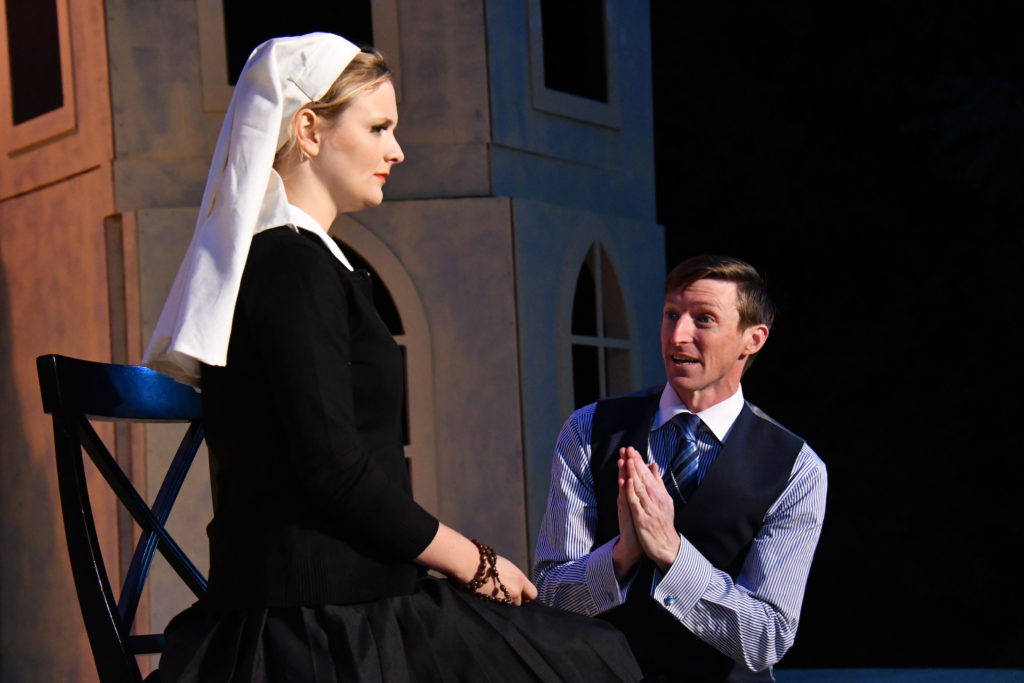
Social Injustice Everywhere You Turn
But sexual harassment is just a small part of the social injustice Currier targets. The production also speaks to abuse of power, official corruption, passive acquiescence to intolerable behavior even by those with troubled consciences, racism, religious hypocrisy and, more directly than anything else, the terrible blight of over-incarceration that results from a toxic mix of all these ills.
Currier and the company he co-leads (with his wife, Lesley Schisgall Currier) certainly have the moral authority to make the statements they are making. Despite being a relatively small company, Marin Shakes is the largest provider of Shakespeare in Prison projects in the world, working in over a dozen California prisons. Among them is San Quentin (where this production is recognizably placed by set designer Jackson Currier, prop designer Joel Eis and costume designer Tammy Berlin) which sits about five miles from the theatre in San Rafael where the production is performed. One formerly incarcerated performer makes his professional debut in this production, while another is an artist-in-residence (and much awarded performer) with the company.

This exposure clearly informs the setting and performance of the numerous prison scenes in the production. The play’s plot traces the fortunes of a young man, Claudio, who is sentenced to death for impregnating his fiancé before marriage by an overzealous, and (it turns out) hypocritical judge. Ordinarily, the interest in the play turns to the incarcerated man’s sister (a novice on the verge of becoming a nun) who pleads for his case to the judge, who promptly propositions her. Claudio becomes a minor character. In this case, however, Claudio’s cell is situated in the down right corner of the stage, and he is continuously visible for almost the entire play. Brennan Pickman-Thoon brilliantly keeps his character on our minds without ever stealing focus or upstaging the main action. His concentrated performance, however, reminds us how much injustice is being perpetuated simply because it is “out of sight, and out of mind.”
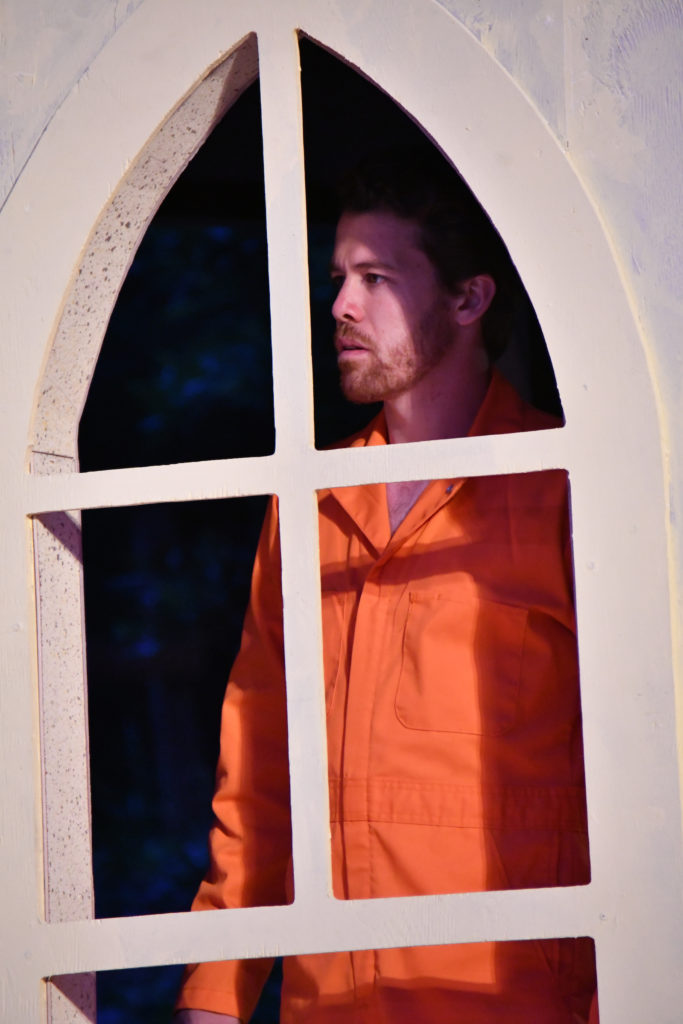
When his sister Isabella (played by Luisa Frasconi) visits, the waiting room walls chillingly host what appears to be real warnings from the corrections department that “staff and visitors will not be considered hostages for bargaining purposes,” along with zero tolerance statements required by the Prison Rape Elimination Act. She and all others are subject to realistic electronic scans upon arrival at each and every entrance.
The purpose of her visits is to tell her brother than the corrupt judge (played by Joseph Patrick O’Malley) has offered to commute his death sentence in return for sexual favors, but she has declined. She asks, and expects, her brother to die for this principle, and brutally denounces him when he suggests that perhaps it would not be a mortal sin under these circumstances.
The Problem of a Problem Play
Currier’s production is undecided how to handle this, and several other incidents. MM, like its fellow problem play, The Merchant of Venice, is structurally a comedy, but much of it cannot be played for laughs anymore—if it ever could—and finding the right tone is difficult. On opening night the production frequently miscalculated how far to joke and temper the central—sexual harassment—scenes.
Low Comedy When Its Called For
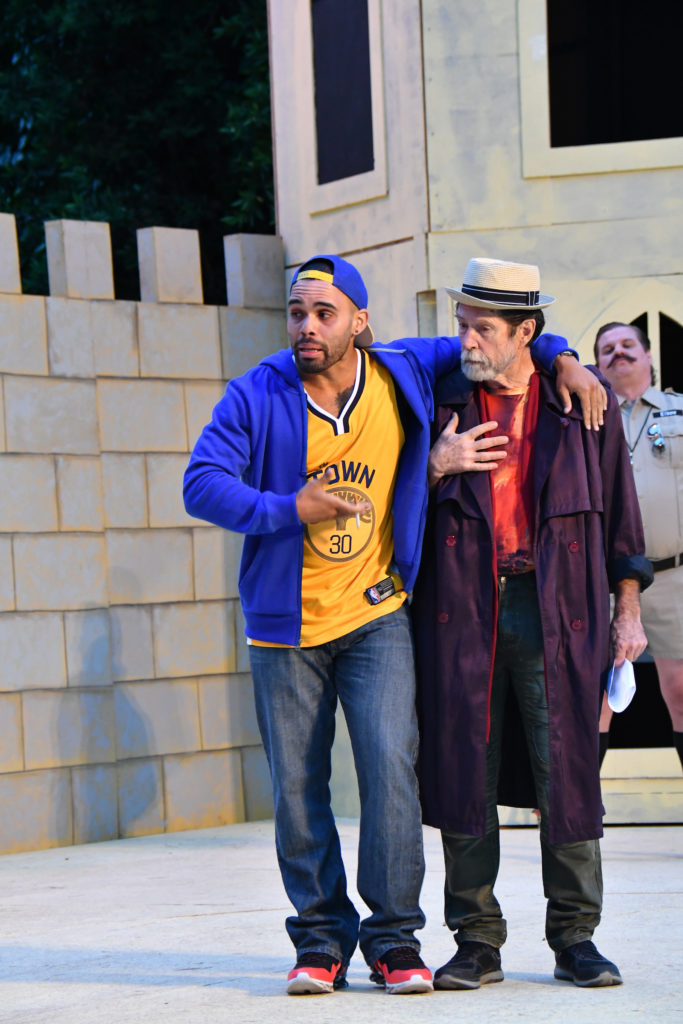
Audiences might yet steer it to a more sensitive place, especially since it doesn’t need the main characters to provide comic relief. As it is, the outstanding performances in the play are by the low comedians, especially Ed Berkeley as the pimp, Pompey, who adlibs much more than is “set down for him,” but with perfect timing and excellent deadpan delivery. Ariel Zuckerman as Lucio and Isabelle Grimm as Mistress Overdone were also very funny.
Big Impact
In the end, however, the production still found its impact. Currier has a knack for capturing the zeitgeist, and this production has the same nervous and uncertain feel that everyday life seems now to have. Without spoilers, suffice it to say that this production also declined (without changing any text) to offer the traditional reassuring ending. It was honest enough to make us question what will happen next.
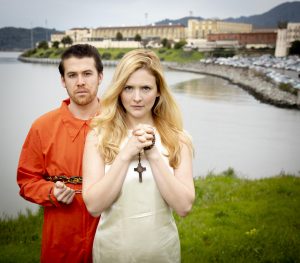
Production Information
Measure for Measureby William Shakespeare (seen, June 29, 2019)
Thursdays through Saturdays at 8 pm; Sundays at 4 pm, through July 21
Forest Meadows Amphitheatre, Dominican University of California, 890 Belle Avenue, San Rafael, CA.
Tickets: $10 – $38, 415-499-4488, www.marinshakespeare.org.
What’s Your Problem?: A Review of MEASURE FOR MEASURE at CalShakes
September 27, 2017 § Leave a Comment
Measure for Measure, Shakespeare’s rhetorically brilliant but generically ambiguous “comedy,” is perpetually a problem. Tyne Rafaeli, directing for co-producers, the California Shakespeare Theater (CalShakes) and Santa Cruz Shakespeare, provides a fascinating approach that does not “solve” the difficult text (and in some ways complicates it even further) but does provide a set of visual tableaus and cleverly staged moments that make it especially relevant to the Bay Area audiences and the fraught political moment in which we live.
Why the play is so difficult is no particular mystery. Shakespeare adapted a completely tragic story (from the same source that he used for Othello) then – through the addition of a couple of hoary plot devices – restructured it into a comedy. Although everything does work out in the end, the tone of the play remains predominantly dark, however, so it is hard to know how lightly to take it and what to make of the moral dilemmas it poses.
Power and Perversion
The convoluted plot is the story of a Duke who is reluctant to exercise his power to maintain order, and so temporarily turns his duties over to a puritanical deputy with no such qualms. To set an example, the replacement ruler immediately sentences a young man to death for the relatively minor crime of impregnating his fiancé before marriage. The young man’s sister (a novice on the verge of taking her vows to become a nun) makes an impassioned argument for his life, which perversely just excites the cold deputy’s lust. He propositions her, offering the brother’s life in return. Faced with what is known in literature as the monstrous bargain she refuses. “More than our brother,” she declares, “is our chastity” – a position that modern audiences, at least, do not always find sympathetic.
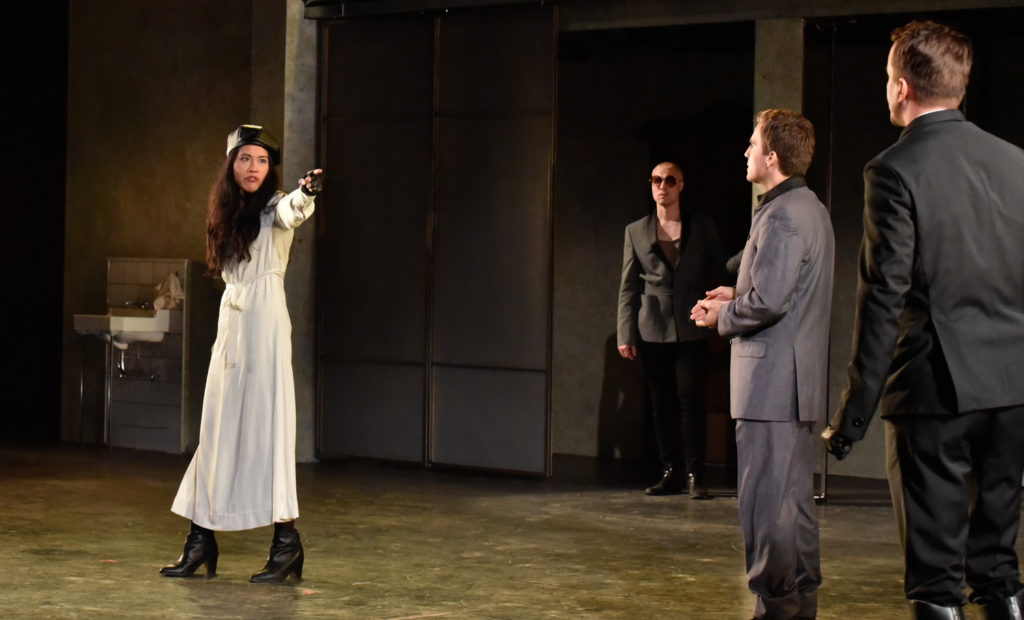
(L to R) Lindsay Rico (Isabella), Adam Schroeder (Lucio), Rowan Vickers (Duke) and David Graham Jones (Angelo) in California Shakespeare Theater’s MEASURE FOR MEASURE, directed by Tyne Rafaeli; photo by Jana Marcus.
Oddly, the Duke is lurking about in disguise and convinces the heroine to pretend to assent, and then substitutes the deputy’s rejected fiancé in the darkened bedroom. In a not-all-that-shocking twist the deputy, even though he is fooled by the substitution, still orders the execution to go ahead. The Duke has to struggle around in the background to prevent tragedy, and eventually resumes his position in order to set things right – just not until after he has convinced the young man that will have to die, convinced his sister that he did die, and convinced the hypocritical underling that he got away with it all. (Although manipulative, it is probably supposed to have a Big Yellow Taxi effect.) By the time the ending comes, when the Duke proposes to the would-be nun, the audience has been bounced between the poles of starkest tragedy and melodramatic relief several times.
Visualizing Psychology
Rafaeli imbues her production with an artificial urgency throughout, which makes it all look and feel much more like a farce. This certainly reduces the tonal whiplash we usually experience in productions of this title – but also rushes the detailed explanations of what is happening (and why) to the point that it is often far from clear to anyone not already familiar with the play what is transpiring.
What is genuinely original, and pretty wonderful, about the production is how Rafaeli makes many of the most difficult assumptions in the play more comprehensible through striking visual compositions. She stages the propositioning scene as a graphic sexual assault, sending the heroine initially into frozen shock – a haunting tableau that sums up the abuse of power and the helplessness of victims in a single image. Isabella’s subsequent revulsion at the idea of having sex, even to save her brother’s life, becomes psychologically comprehensible. (Given that we are living under a happily “pussy-grabbing” president, it also makes it inevitably political.)
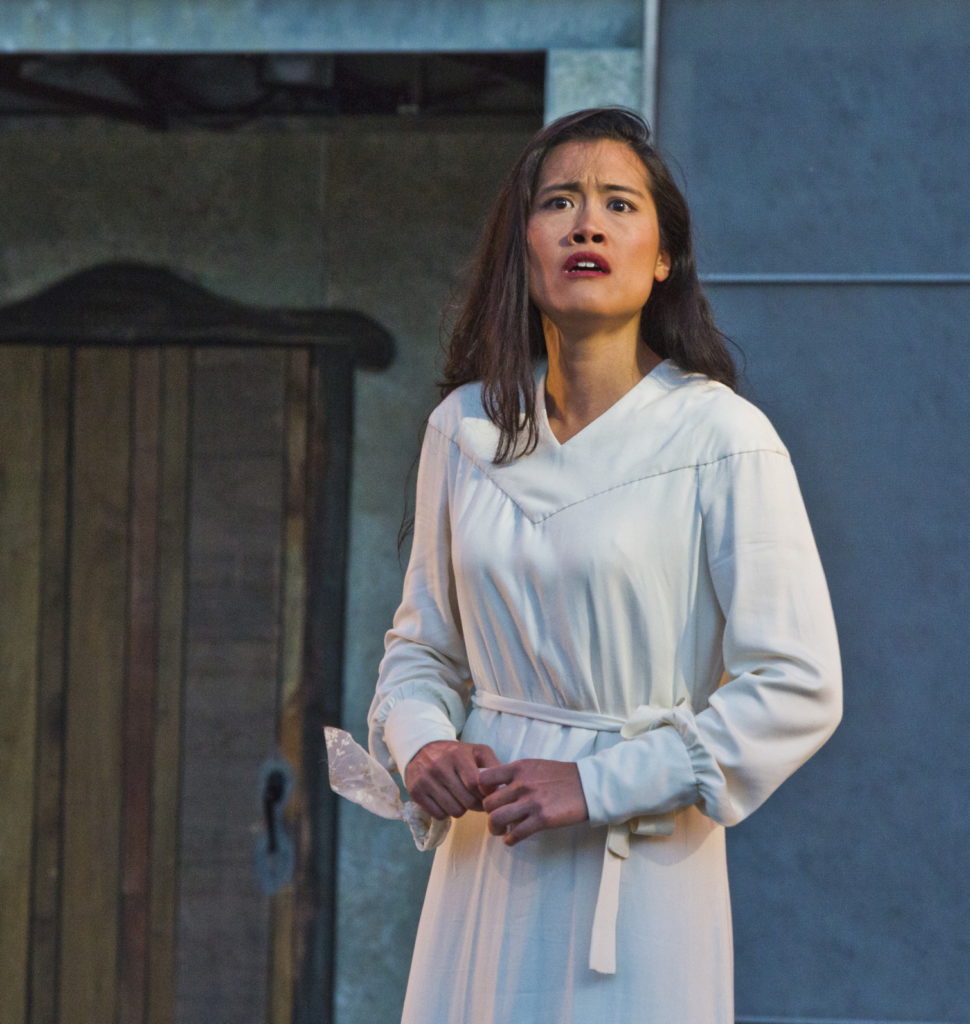
Lindsay Rico (Isabella) in California Shakespeare Theater’s MEASURE FOR MEASURE, directed by Tyne Rafaeli; photo by rr jones.
Her brother, whose punishment vastly outweighs his crime, is played by an actor of color. Rafaeli’s staging of his scenes of imprisonment with starkly contemporary details to the cell is surely meant to remind us of the injustices of our current system that disproportionately imprisons black and Latino men. A stumbling block for many Measure for Measure audiences is often that they find the overly-harsh sentence silly instead of serious, but in Rafaeli’s context it is all too plausible – again speaking to both the local audience and current moment.
A Different Kind of Setting for CalShakes
Throughout the play, Rafaeli uses the broad, shallow setting to create quick visual snapshots of important moments that remind us of nothing so much as eye-popping comic book panels freezing the action into bold compositions. Although wide and flat, Annie Smart’s set is both functional and effective for this purpose. It is very unlike the usual stage sets in CalShakes’ outdoor location where seeing into the far distance is possible. Montana Levi Blanco’s modern dress costumes often border on the whimsical. It is Kent Dorsey’s lighting that ultimately makes Rafaeli’s visual summaries burn into our consciousness.

Adam Schroeder and Annie Worden in Montana Levi Blanco’s fantastical costumes.
There are No Small Parts
To achieve the contemporary resonance, both verse speaking and self-conscious rhetoric were sacrificed to more physical approaches. As a result, the small players were often the most interesting members of the cast, especially Annie Worden’s rapid-fire turns as the Mistress Overdone, the Dogberry-like constable Elbow, the belligerent drunk, Barnadine, who farcically refuses to be executed, and Mariana, the heartbreakingly rejected fiancé of the false deputy who finally reclaims him from his own hypocrisy. CalShakes favorites Tristan Cunningham and Patty Gallagher also produce compelling and varied performances across a number of roles, as does newcomer Kevin Matthew Reyes as the brother, Claudio, and his polar opposite, the amusing pimp Pompey.
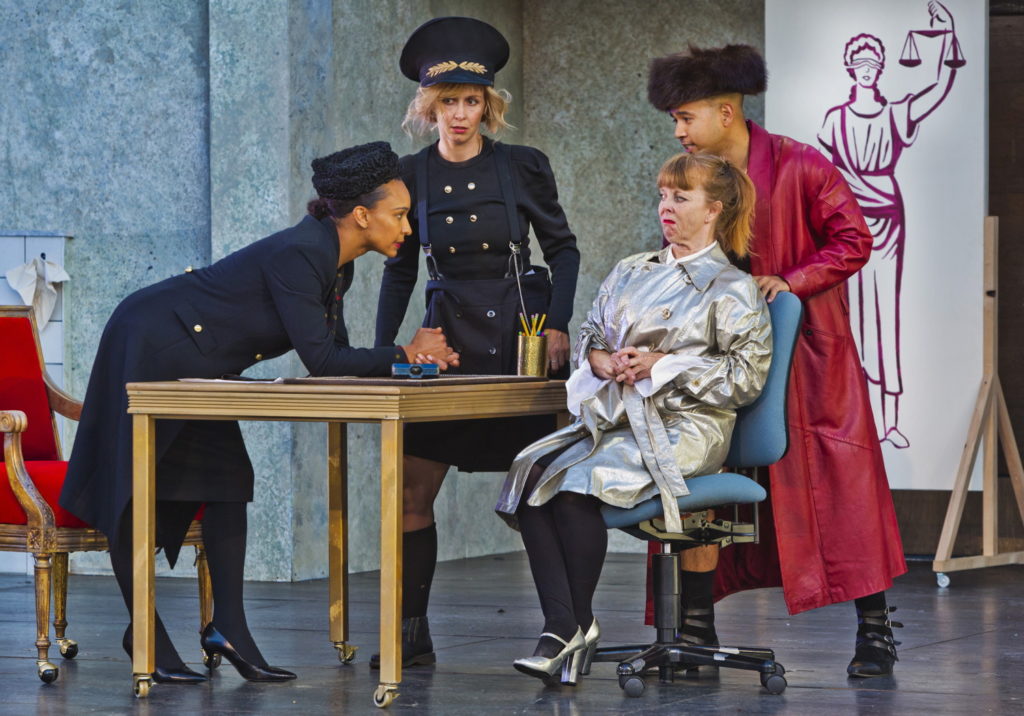
(L to R) Tristan Cunningham (Escalus) and Annie Worden (Elbow) question Patty Gallagher (Froth), and Kevin Matthew Reyes (Pompey) in California Shakespeare Theater’s MEASURE FOR MEASURE, directed by Tyne Rafaeli; photo by rr jones.
In the end, this production was a reminder that there is no such thing as a definitive staging of any Shakespeare play. There are endlessly fascinating possibilities, however. Measure for Measure is often a showcase for exceptional voices and fine verse speaking. It is almost unique to see it staged as a director’s vehicle emphasizing visual pictures and physical comedy. It is hard for me to remember any production of this show that was so closely tuned to place and time in which it was presented.
A Classic Reborn: a Review of BLACK ODYSSEY at CalShakes
August 14, 2017 § Leave a Comment
At the center of poet/playwright Marcus Gardley’s black odyssey (now playing at the California Shakespeare Theater) is the eternal impulse to retell a classic tale in order to claim it as one’s own. For those of us who regularly teach the classics, this is the lesson we seek to foster: the purpose of retelling these stories is not to perpetuate the past, but to connect to it. It is impossible to leave Eric Ting’s masterful production without feeling a part of something bigger than one’s own limited space and time.
A Paradox
Gardley’s reworking of the Homeric epic gains its force from the paradoxical rule that universality is achieved not by vacuous generality, but in precise specificity. On its surface, his play is about an African-American veteran of the contemporary (and ongoing) war in Afghanistan, named Ulysses Lincoln, who cannot find his way home. Over the course of the evening it becomes clear, however, that he is not so much geographically lost as spiritually at sea. His journey is not just finding his home, but finding himself.
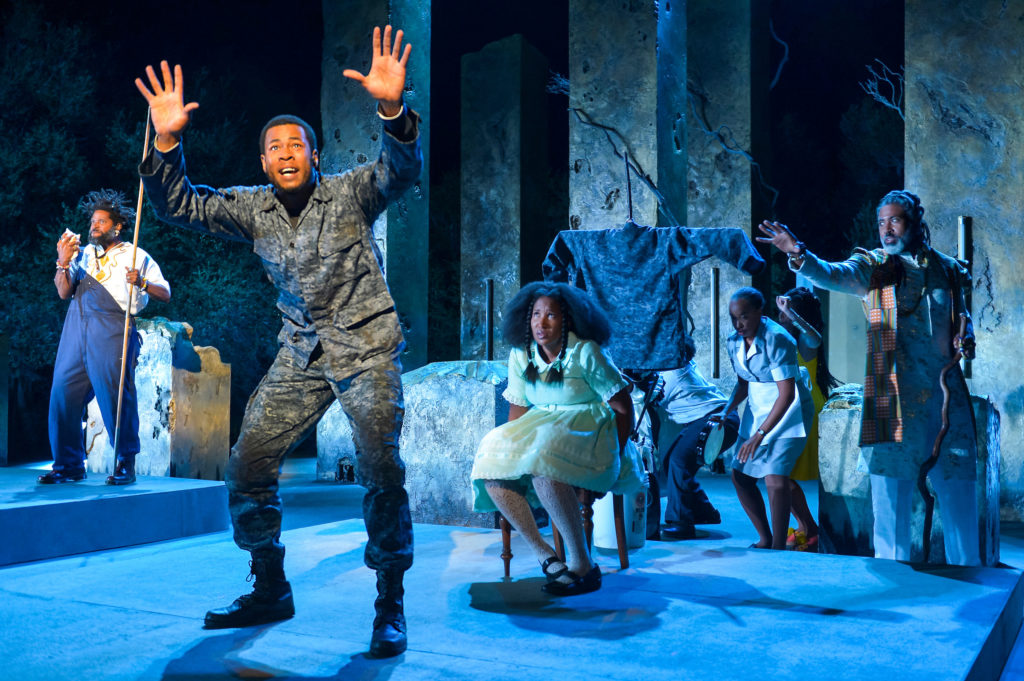
(l to r) Aldo Billingslea (Great Grand Paw Sidin), J. Alphonse Nicholson (Ulysses Lincoln), Safiya Fredericks (Benevolence Nausicca Sabine), Dawn S. Troupe (Alsendra Sabine) and Lamont Thompson (Great Grand Daddy Deus); photo by Kevin Berne
After being swept overboard of the ship carrying him home by a wave caused by the vengeful sea god, he washes up on a shore that – we slowly realize – is located both far from his intended destination and decades before he was born. The path to self-knowledge runs through the discovery of a history that was in some ways actively withheld from him through erasure and distortion, and in other ways that he actively fled when he joined the army to get himself out of Oakland. Although this is one man’s specific story, Gardley guides us to seeing beyond the surface, making it also a story about all of us.
Epic
Like any true epic, the plot is anything but linear. It is dotted with witty reïmaginings of the arbitrary and capricious Greek gods Paw Sidin (Poseidon), Aunt Tina (Athena) and Great Grand Daddy Deus (whose name is pointedly changed from Zeus to the Latin generic term for “god,” presumably because it also applies to the god of Christian tradition) who toy with human fate for reasons of their own. It retains the secondary story of the struggles of his wife, Penelope (here called Nella P.), and son, Telemachus (Malachai in Gardley’s version), to survive and retain hope, while placing them in a very recognizable 21st century Oakland. Often it focuses on the surreal experiences of the wandering Ulysses.
Along the way Gardley invokes Hurricane Katrina, the string of assassinations of civil rights leaders, Abraham Lincoln, JFK, Treyvon Martin, the death of Oscar Grant in the Fruitvale BART Station, reconstruction, and a host of other historical and local references that stir times and places together poetically. Painfully, I saw the opening night performance just hours after a white supremacist march in Charlottesville, Virginia, erupted in fatal violence against counter-protesters, which did not need to be directly referenced in order to be part of the mix.
A Great Feast of Language
Gardley is as much poet as playwright. His rhythms, rhymes and wordplay are both stunningly current and historically apt. For anyone who loves language black odyssey is a feast. CalShakes consistently demonstrates careful attention, not only to what is said, but how it is said. Gardley is at his most Homeric in his extravagant use of poetic artifice, and the producing company serves his inventive wit well.
The production heavily features music, especially arrangements of traditional spirituals. Vocal composers Linda Tillery and Molly Holm produced the strongest musical ensemble I have seen at CalShakes. (Tillery is also the credited Music Director, while Holm is also listed as Vocal Ensemble Director.) While I was less impressed with the brief forays into pop music in the second act, it is hard to underestimate how much of the overall impact of the production is built on the musical components. When the full cast is united in a choral moment, which happens rather often, the wall of sound they create is viscerally moving.
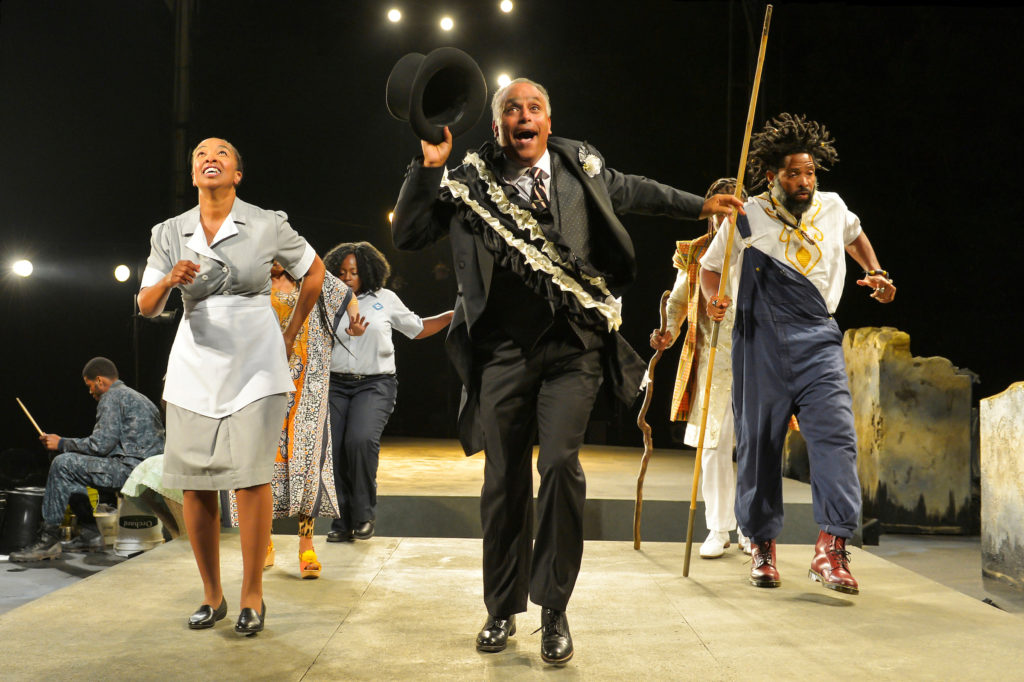
The cast of Marcus Gardley’s black odyssey directed by Eric Ting at California Shakespeare Theater; photo by Kevin Berne
Nine Stars
However much all of that matters, the evening is also about basking in the masterful performances of an exceptional cast. As Ulysses, actor/percussionist J. Alphonse Nicholson accomplishes the enormously challenging task of portraying a lost soul without fading from focus or losing his energy. His humanity and generosity as a performer letting us glimpse his innermost self allows us to identify with him intensely. Omozé Idehenre proves an emotional anchor for the entire evening as his long-suffering wife. Newcomer Michael Curry completes the family trinity as his son, Malachai, movingly and believably, even when the role shines an unsympathetic light on his character. In a conventional drama, this family grouping would be our entire focus and we would be content with such central performances.
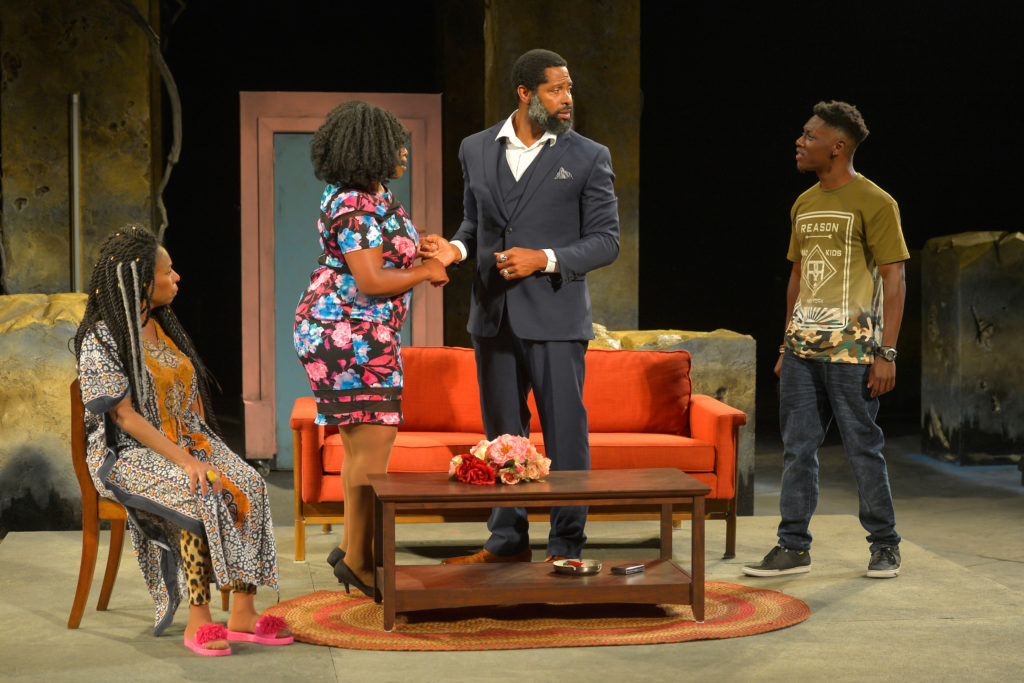
(l to r) Margo Hall (Great Aunt Tina), Omozé Idehenre (Nella Pell), Aldo Billingslea (Suitor), and Michael Curry (Malachai); photo by Kevin Berne
In this cast, however, the peripheral players are every bit as compelling. CalShakes regulars Aldo Billingslea and Margo Hall are powerhouses as the squabbling gods whose conflict lies behind Ulysses’ trials. Both also demonstrate astonishing versatility as they transform into their respective gods’ alter-egos. Billingslea invokes Paw Sidin as a coverall-clad levee fisherman but when he incarnates as a smooth-talking suit salesman wooing Nella P., a crisp military officer offering the wrong kind of solace when he brings news that Ulysses is lost and presumed dead, and a terrifying policeman, he appears completely different in each case. When Hall’s Athena sloughs off her immortality to become Aunt Tina, an aging and ill human, we see her change right before our eyes. And her invocation of Tina Turner (as one of the Sirens) is, well, let’s just say worth the price of admission all by itself.
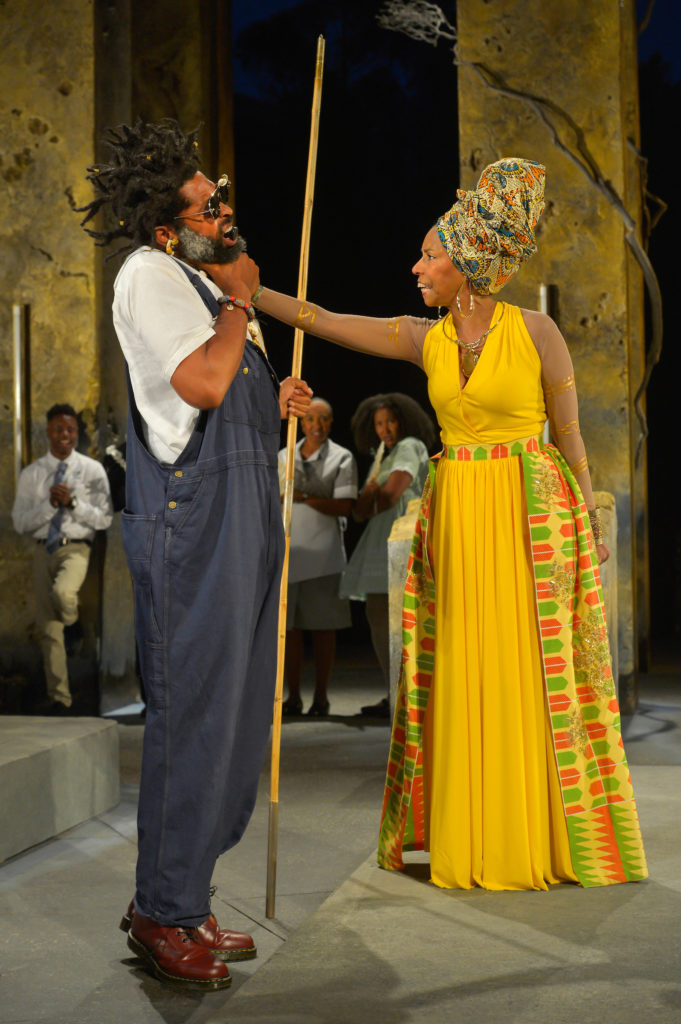
Foreground: Aldo Billingslea (Great Grand Paw Sidin), Margo Hall (Great Aunt Tina); rear: Michael Curry, Dawn L. Troupe, and Safiya Fredericks. Photo by Kevin Berne
Are these five great performers the magic number? Hardly. They are actually just the start of a cast of astonishing depth. Lamont Thompson as Daddy Deus is majestic, and in various minor roles he ranges from mysterious to hilarious. Bay Area playwright/performer Michael Gene Sullivan (best known for his work with the San Francisco Mime Troupe) appears – and sometimes disappears into – so many guises it’s hard to stay clear that it is the work of just one man and not a cast of dozens filling in. Dawn L. Troupe is Sullivan’s female equivalent in the cast playing a range of roles, sometimes prominent and sometimes almost invisible, providing enormous texture and depth to the play.

Dawn L. Troupe as Circe and J. Alphonse Nicholson as Ulysses Lincoln in Marcus Gardley’s black odyssey directed by Eric Ting at California Shakespeare Theater; photo by Kevin Berne
The nine-person cast is rounded out by Safiya Fredericks, whose light and amusing performance of Ulysses’ childish traveling companion conceals an artfulness and control that is only revealed when the entire play has unfolded. It is unfair that her masterful work cannot be discussed in detail without spoiling the play, but it can be said without harm that her genius lies in knowing when and how to unleash her talent, and it is worth the wait.
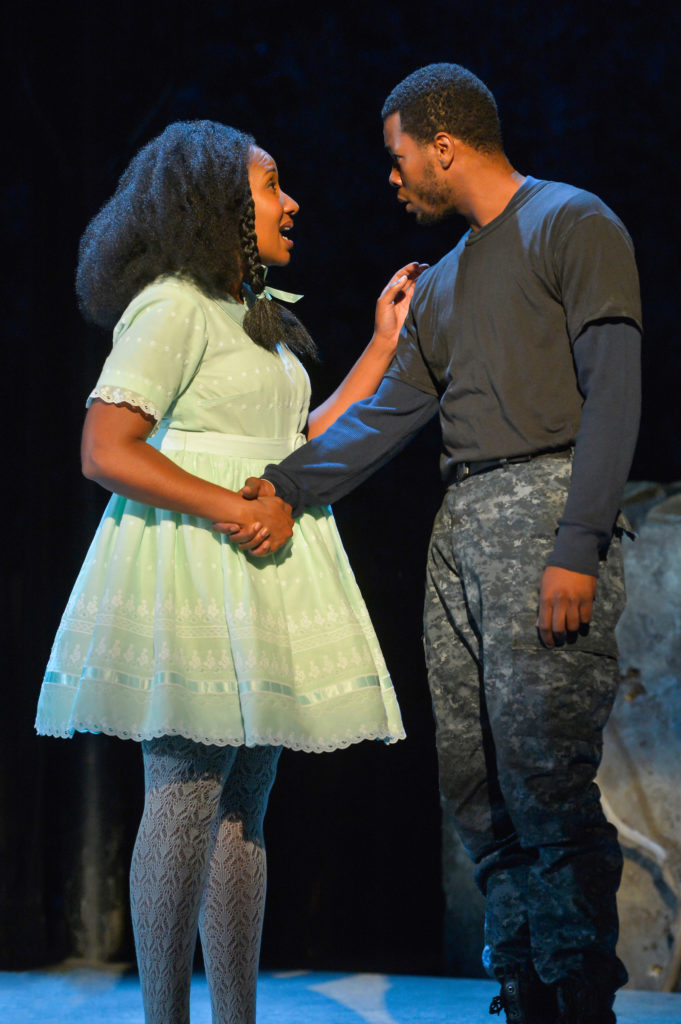
Safiya Fredericks (Benevolence Nausicca Sabine) and J. Alphonse Nicholson (Ulysses Lincoln); photo by Kevin Berne
One Small Man in a Huge World
The action of the play happens almost exclusively on an empty platform in front of Michael Locher’s monumental set, but the dynamic visual impression created by the towering (and crumbling) pillars sets the right tone throughout the night. Locher is especially successful at tying the stage space to CalShakes’ astounding natural setting in the Berkeley hills. That gorgeous view is always one of the pleasures of attending a CalShakes production. In a piece this grounded locally, it was especially admirable that the surrounding environment was featured. Abetted by the outstanding work of Lighting Designer Xavier Pierce, both the onstage action and the larger surroundings remain in balance. Thematically evocative, the image of one small man making his way in the huge world could not have been more beautifully rendered. Costumes by Dede M. Ayite successfully mix the mundane (for scenes of domestic depression) and the fantastic (in the otherworldly visions of Ulysses), which is not an easy trick to pull off.
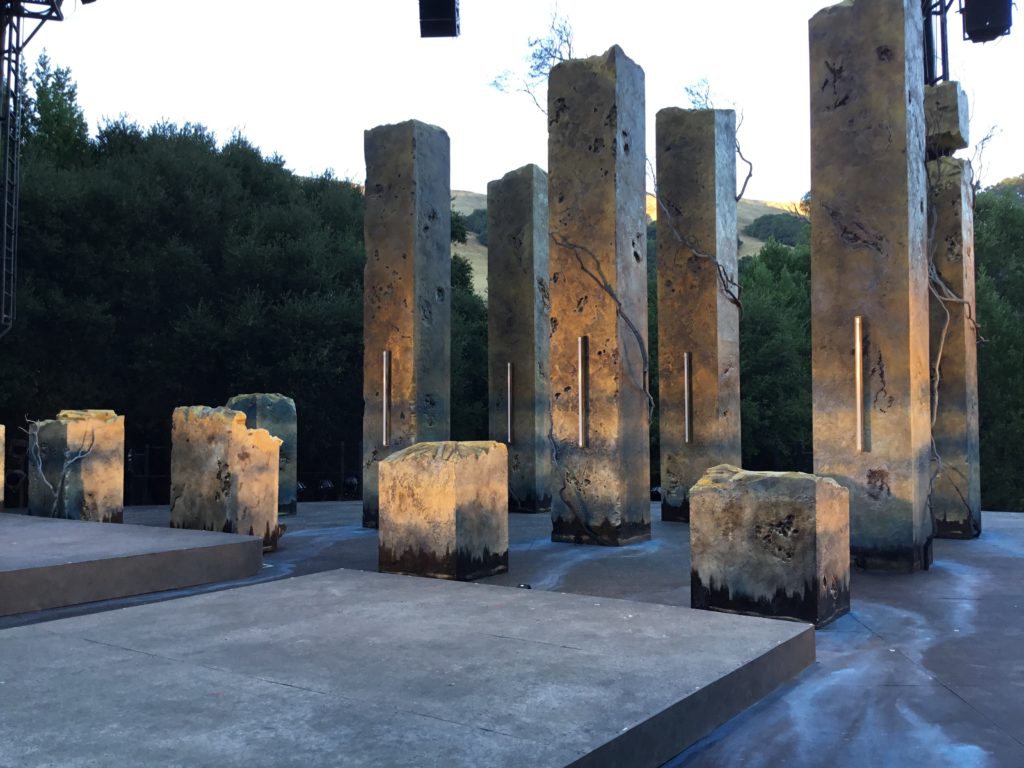
Michael Locher’s set lit by the pre-show sunset. Photo by the author.
Empathy
Ting’s directing is an astonishing act of empathy by a man who is, after all, of Asian-American decent, who is empowering an African-American cast to claim and interpret a story whose specifics are outside his direct experience. In his company debut as a director a year ago his Brechtian production of Othello proved controversial in part because (as is the way with such productions) we were not so much asked to empathize with Shakespeare’s hero, but told to do so. I am among those who actually like a stern lecture now and then and I liked Ting’s production, but I concede it was more Brecht than Shakespeare.
In this case, Ting seems an absolute servant to Gardley’s vision. It is hard for me to imagine that even those who found his Othello difficult will not find this an inviting experience. It is a sensitive and insightful rendition of a beautiful play, allowing a local playwright and cast to stake a claim on a work considered foundational to the Western tradition in a truly universal way. By making Homer their own they remind us that no one owns or directly inherits the past. We all have to find our humanity.
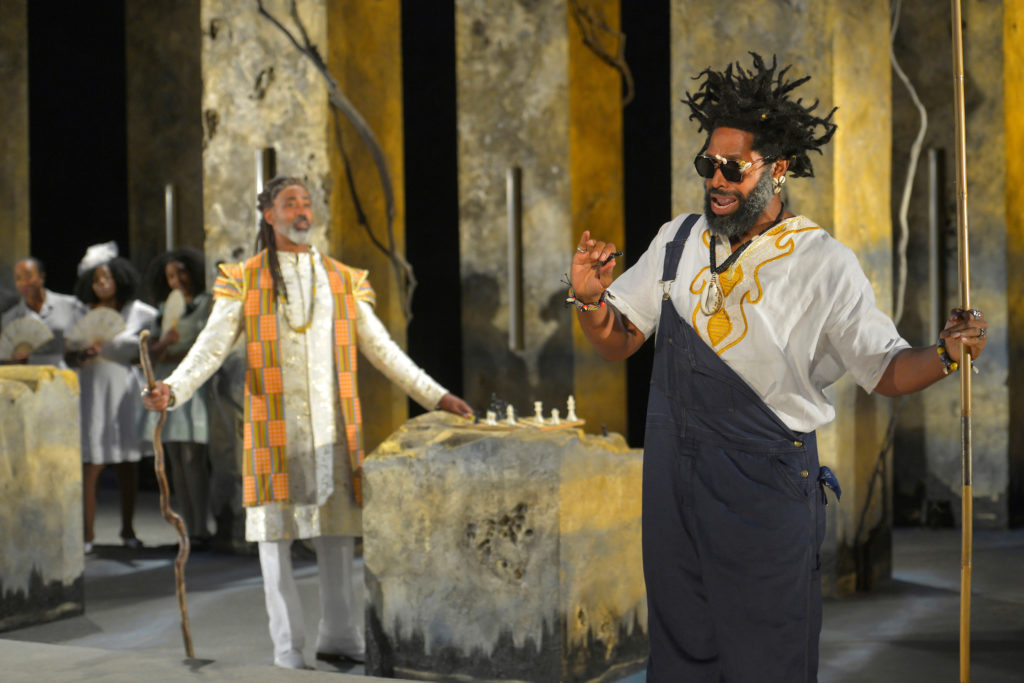
(l to r) Lamont Thompson as Great Grand Daddey Deus plays chess with Aldo Billingslea as Great Grand Paw Sidin, while Dawn L. Troupe, Omozé Idehenre, and Safiya Fredericks look on in Marcus Gardley’s black odyssey directed by Eric Ting at California Shakespeare Theater; photo by Kevin Berne
Production seen on August 12 2017
WHEN: through September 3, 2017
Tuesdays through Thursdays at 7:30pm, Fridays and Saturdays at 8pm, Sunday Matinees at 4pm
WHERE: Bruns Amphitheater, 100 California Shakespeare Theater Way, Orinda, CA 94563
INFO: www.calshakes.org
Still the Most Produced Playwright in America: Shakespeare
September 23, 2016 § Leave a Comment
American Theatre Magazine has released its annual, informative listing of the most produced playwrights in America among the members of the Theatre Communications Group, which consists of virtually all of the USA’s regional theatres. It is a listing I always find fascinating and of great use to my students. Perpetually, however, you have to read to the bottom of the page and look at the small print to find the real answer to the question:
Their footnote on methodology says:
“NOTABLE OMISSIONS: Shakespeare continues his long reign as the most-produced playwright in America, with 91 productions this season (including adaptations). And Stephen Sondheim continues to be the most-produced musical theatre composer in America, with 15 productions this season. It’s not just children who are listening…”

Still #1
The most produced playwright this year that they do count is August Wilson with 17 productions, followed closely by Bay Area playwright Lauren Gunderson with 16. Sondheim would place third on this list (tied with Arthur Miller) if composers were considered.
Still, those four playwrights combined have fewer productions than Shakespeare. You can throw in Ayad Akhtar and Tennessee Williams, the fourth place finishers at 14 each, and you still just tie Shakespeare’s number.
Just sayin’
Shakespeare Resources
January 9, 2016 § 1 Comment
The New York Public Library announced this week that they were making 180,000 digitized public domain images available for hassle-free downloading and use. (See the announcement here.)
The collection contains some wonderful images of interest to Shakespeareans. As an example, have a look at this “book” of images related to Macbeth. It contains numerous photos of full productions like one of the Old Vic and the famous Orson Welles “Voodoo” Macbeth, and a set of photos of studio shots of Lady Macbeths like Sarah Bernhardt, Sada Thompson, Ellen Terry, Lili Langtry.
The collection is especially rich in photos from the early years of the New York Shakespeare Festival’s free Shakespeare-in-the-Park productions – like this one of Christopher Walken in Macbeth:
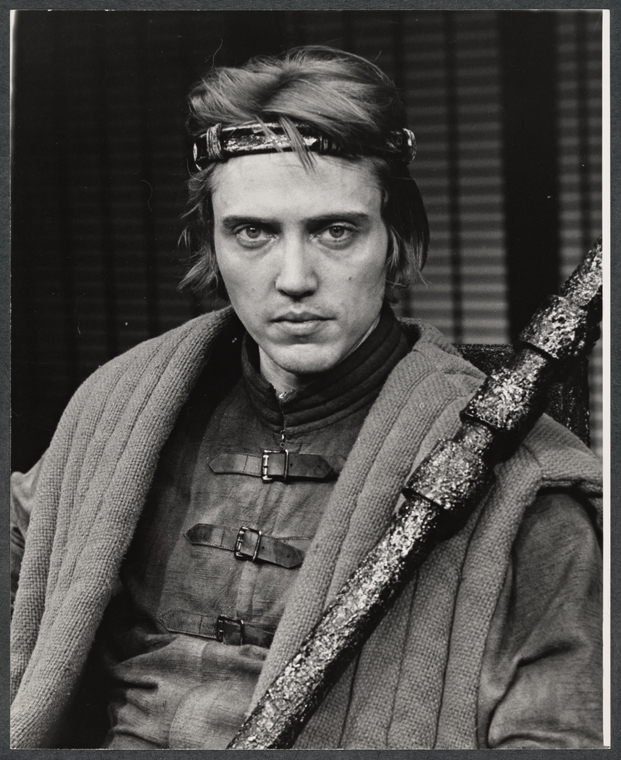
Walken in Macbeth, 1974
The possibilities are extensive. Next time you can afford to get sucked into an hour or two of browsing, check it out.
Taymor’s film of MIDSUMMER announces additional showings in NYC, and around the US
July 26, 2015 § Leave a Comment
Three additional New York showings of Julie Taymor’s film of her theatrical production of A Midsummer Night’s Dream have been announced. The first is this Thursday, July 30.
Full information is available here.
I reviewed this film earlier. My review is available here.
Additional showings around the country are available at this location.
Twelfth Night – What’s with that Title?
January 6, 2015 § Leave a Comment
Today is Jan. 6, The Feast of Epiphany – which happens on the twelfth day after Christmas. As anyone who has been bombarded with multiple versions of “The Twelve Days of Christmas” during the holiday season knows, Christmas used to be an extended celebration culminating on Epiphany – as it still is in several European countries. In fact, in Shakespeare’s time Christmas itself was a more muted and religiously-focused event, and the celebrations grew larger every evening until Twelfth Night. (In line with ancient Judeo-Christian tradition the days began at sundown the evening before, which is why we still have such a focus on Christmas Eve. Using this rule, Twelfth Night was celebrated in the early modern period on the night of Jan. 5 – Epiphany Eve, as it were.)
All that is reasonably clear, and explains the event which gives Shakespeare’s play its name. The complication, of course, is that nothing in the play really suggests that the play takes place during the Christmas season, or has anything directly to do with the twelve days of Christmas at all. So why the name?
For that, we have to realize that Twelfth Night was a raucous celebration, a sort of cross between our modern New Year’s Eve and Mardi Gras parties. Part of the festivities was the inversion of norms. A “Lord of Misrule” was often appointed to supervise the event – generally a youth or a servant with an outgoing personality and a wicked sense of parody. The distinction marking social classes were briefly relaxed and everything turned topsy-turvy. It was a time to blow off some steam, and frequently to ridicule the excesses of authority.
Twelfth Night, the play, features many such reversals. The social climbing Malvolio acts far above his station and inappropriately dreams of “having greatness thrust upon him.” Viola is in disguise as a eunuch, Cesario. Viola’s name is a near anagram of Olivia’s, reflecting their interlocking oppositions on the subject of love. (In one case Olivia does not love where Viola does, and in another Viola loves where Olivia does not.) Sebastian is mistaken for his twin, and finds himself the object – rather than the initiator – of intense wooing.
The title, like those of Comedy of Errors and Much Ado about Nothing, suggests comic chaos. In this case, not because it happens on Twelfth Night, but because it is as disordered and inverted.
The Most Produced Plays in America…sort of.
September 28, 2014 § Leave a Comment
Theatre Communications Group Has a List!
Every season, Theatre Communications Group (TCG) – the organization of America’s not-for-profit theatres – puts out a list of the 10 most produced plays by its nearly 500 members. (Because they recognize ties, this year it is actually a top 11…) Although it covers only a segment of the American Theatre scene, (because it does not include for-profit, academic, or amateur theatres) its annual list is a quick way to get the pulse of what plays and playwrights are currently hot.
That is a very useful list for performers thinking about where to put their time and energy familiarizing themselves with scripts, with names to watch, and with sources for audition material. Because I know it gets used that way, every season I also put out my own annual rant reminding students and actors of a surprising omission.
And the winner is…
In this year’s list, published just last week, the top spot goes to Christopher Durang’s Vanya and Sonia and Masha and Spike which has a whopping 27 productions scheduled across the nation this year. There is no sense in which it can said the American theatre marches in lockstep, however. A measly ten productions earn the second spot for Outside Mullingar by John Patrick Shanley, and it only takes six productions to earn a place in the top 10, …er 11.
For the last season for which complete records are available (2013-14), 23 productions were enough to earn the top spot for David Ive’s Venus in Fur, which managed to hang on this year to a six-production tie for tenth place. Two other titles on the current list were also represented last year, but there is rather fast turnover from year-to-year. (The top production on the list a decade ago, for example, was The Drawer Boy by Michael Healey, which is scheduled for how many productions this year? Oooow, zero.)
The Problem with the List
The list is a little misleading, however, because TCG makes two exclusions to their counts: They do not include holiday shows, like the ubiquitous Christmas Carol and the current small budget alternative, The Santaland Diaries, the first of which would be the perennial winner of the top spot.
More surprisingly, they do not list plays by Shakespeare. Yet every year Shakespeare plays would rank quite high on the list if they did. In the current season, according to a title search using TCG’s data, 11 productions A Midsummer Night’s Dream would actually earn second place on this list if it were recognized.
Ten Tempests would make it third on the list, in a tie with Shanley’s play. Nine Hamlets would garner it fourth place. King Lear, Romeo and Juliet, and Macbeth would make the cut, tying with three other titles that have six productions each scheduled. Both As You Like It and Comedy of Errors are just one production shy of also making the list. That is eight Shakespearean titles in a top 11 list (with ties), while no other playwright is represented even twice.
All told, according to a quick search of the TCG website, Shakespeare has a total of 108 productions and/or adaptations in the 2014-15 season – actually a surprisingly low number – but still far above the second place finisher (Dickens at 46) and the top living playwright (Durang at 28). The year before (when the 450th anniversary of his birth fell) he received 127. The year before that, he received 153. The year before that 148.
My purpose is not to quarrel with TCG’s exclusions. They are open about their methodology, and their support of new American work. As they tactfully put it in a footnote, there are only so many ways to say that A LOT of companies do a version of A Christmas Carol each year – although almost every one of those is the work of a different adapter. There is also no comfortable way to note, year after year, that if they included Shakespeare’s plays he would dominate the list and push some living, struggling playwrights entirely off.
America’s Most Produced Playwright
When students ask me, however, about where to spend their time and energy, I am always quick to remind them the most produced playwright in America – who, by the way, has occupied this position for every single year of the last hundred years – is William Shakespeare. If I were going to study just one play in depth, I think I’d pick the most produced play in America over the last decade which is…A Midsummer Night’s Dream.
The Fall Classical Theatre Season in the San Francisco Area
September 2, 2014 § Leave a Comment
As summer winds down, so does the number of pre-modern plays on local stages, but there are a few festivals with seasons continuing into fall and a small number of additional productions. Of particular note are the two continuing productions by the Marin Shakespeare Festival and the upcoming Midsummer at CalShakes helmed by the wonderful young director Shana Cooper. I personally am also really anticipating the production of Shakespeare’s R&J, a four-person adaptation of Romeo and Juliet by Joe Calarco which will play at the New Conservatory Theatre Center.
Continuing until Sept. 7
PENTHESILEA adapted from Heinrich Von Kleist by Guilio Perrone
Actor’s Ensemble of Berkeley
Live Oak Theatre
1301 Stattuck Ave.
Berkeley, CA
aeofberkeley.org
Continuing until Sept. 14
TAMING OF THE SHREW
San Francisco Shakespeare Festival
Presidio Main Parade Grounds
San Francisco, CA
sfshakes.org
also playing at McLaren Park – Jerry Garcia Amphitheater Sept. 20-21
Continuing until Sept. 14
A MIDSUMMER NIGHT’S DREAM
Half Moon Bay Shakespeare Company
John L. Carter Memorial Park
Stone Pine Road
Half Moon Bay, CA
hmbshakespeare.org
Continuing until Sept. 14
THE TEMPEST
Curtain Theatre
Old Mill Park Amphitheatre
Mill Valley, CA
curtaintheatre.org
Continuing until Sept. 27
AN IDEAL HUSBAND by Oscar Wilde
Continuing until Sept. 28
ROMEO AND JULIET
Marin Shakespeare Company
Forest Meadows Amphitheatre
Dominican University of California
890 Belle Ave.
San Rafael, CA
marinshakespeare.org
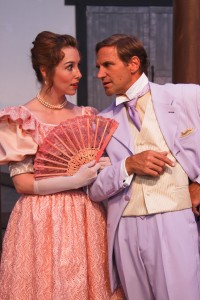
Kate McGrath as Miss Mabel Chiltern and Darren Bridgett as Lord Goring in Marin Shakespeare Company’s production of “An Ideal Husband.”
Sept. 3 – 28
A MIDSUMMER NIGHT’S DREAM
California Shakespeare Theatre
100 California Shakespeare Theatre Way
Orinda, CA
Calshakes.org
Sept. 4 – 28
SAINT JOAN by George Bernard Shaw
Jewel Theatre Company
Center Stage
1001 Center Street
Santa Cruz, CA
jeweltheatre.net
Sept. 12 -28
AS YOU LIKE IT
Shakespeare Napa Valley
Veteran’s Memorial Park
Main St. at 2nd St.
Napa, CA
Shakespearenapavalley.org
Sept. 26 – Oct. 19
THE IMPORTANCE OF BEING EARNEST by Oscar Wilde
Pacifica Spendrift Players
1050 Crespi Drive
Pacifica, CA
pacificaspendriftplayers.org
Oct. 17 – Nov. 15
THE IMPORTANCE OF BEING EARNEST by Oscar Wilde
Santa Clara Players
1505 Warburton
Santa Clara, CA
scplayers.org
Oct. 18 – Nov. 19
THE TEMPEST
African-American Shakespeare Company
Buriel Clay Theatre
762 Fulton St., #305
San Francisco, CA
african-americanshakes.org
Oct. 30 – Nov. 9
THE IMPORTANCE OF BEING EARNEST by Oscar Wilde
Sonoma State University
Evert B. Person Theatre
1801 E. Cotato Ave.
Rohnert Park, CA
sonoma.edu
Nov. 7 – Dec. 12
SHAKESPEARE’S R&J by Joe Calarco
New Conservatory Theatre Center
25 Van Ness Ave, LL
San Francisco, CA
nctcsf.org
Nov. 13-23
OTHELLO
Arabian Shakespeare Festival
Royce Gallery
2901 Mariposa St.
San Francisco, CA
arabianshakespearefestival.org
Nov. 14 – 23
TARTUFFE
Cal State East Bay
University Theatre
25800 Carlos Bee Blvd.
Hayward, SA
csueastbay.edu
Nov. 14 – 23
COMEDY OF ERRORS
Las Positas College
Barbara Mertes Center for the Arts
300 Campus Hill Road
Livermore, CA
lospositascollege.edu
Review: AS YOU LIKE IT at the Novato Theater Company
June 16, 2014 § Leave a Comment
Mark Clark’s production of As You Like It for the Novato Theater Company is powered by an inspired concept: He sets the play in the summer of 1967, opening up all sorts of wonderful insights into Shakespeare’s text.
The second I saw Rosalind (Melissa Claire) in her Ganymede disguise – a Sgt. Pepper-ish “mod” jacket (designed by Janice Deneau) – the play’s gender ambiguity immediately made more sense than in any production I have ever seen. Androgyny was suddenly sexy back then, and Orlando’s inability – or unwillingness? – to see through the disguise was plausible in a way I have never understood it before.

Hannah Jester (Celia), Steve Beecroft (Touchstone), Sumi Narendram (Jaques), Melissa Claire (Rosalind) and Skylar Collins (Orlando)
Since the play centers on Rosalind’s disguise, and her role-playing of a woman – while dressed as a man – to teach Orlando lessons about love (in this case, during the “summer of love,”) that alone would be a great conceptual reason to reset the play, but this particular move yielded greater results than just that.
Duke Frederick’s court was Nixonian in both look (dark suits) and temperament (generational hostility against the “kids”) providing texture and context to the usually unexplained hatred of Orlando’s older brother Oliver toward him, and Duke Frederick’s unmotivated banishment of Rosalind.
The transformational escape to the Forest of Arden invoked the whole back-to-nature hippie vibe, where the court-in-exile of Duke Frederick looked like The Mommas and The Poppas on a rehearsal break. Which reminds me, this play contains more music than any Shakespeare play – which is usually excruciating, lasting forever and contributing nothing. In this case, however, both the lyrics and the mood worked perfectly when recast into the mold of counter-culture folk music accompanied only by an onstage acoustic guitar. Richard Steele’s fine singing as Amiens (backed up by a “girl group” of forest courtiers) was the highlight of first act. Far from seeming added on, the songs of the exiles expressing their disenchantment with the establishment and their yearning for connection appeared completely organic.
The execution of Clark’s concept, unfortunately, could not rise to the level of his direction. As often happens in community productions, the cast was not up to the challenge of Shakespeare – too much “ACTING,” and very little inhabiting of the material. With the notable exceptions of Mark Shepard as Corin/Duke Senior and Robert Nelson as Silvius/William/ominous-secret-service-guy-in-Frederick’s-court, the performances were disturbingly uneven. Both Melissa Claire as Rosalind and Skylar Collins as Orlando widely missed the mark in numerous scenes, although they were exceptionally charming in their scenes with each other.
Even in a production that fails to live up to its potential there can be interesting, indeed compelling, ideas and sporadic moments of genuine emotionality. Given a more experienced, or better trained, cast Clark’s concept might make a great evening.
AS YOU LIKE IT
Novato Theater Company
June 15, 2014

